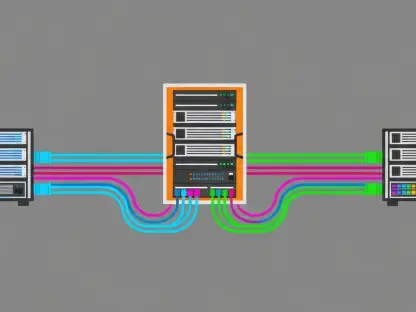In a market often swayed by fleeting trends, Broadcom Inc. (NASDAAVGO) made a resounding statement on November 19 with a remarkable 4% jump in its stock price, closing at approximately $354 per share and elevating its market capitalization to a staggering $1.61 trillion. This notable uptick wasn’t a mere coincidence but rather the result of a series of strategic advancements and industry tailwinds that have positioned the company as a powerhouse in technology and innovation. From groundbreaking product launches to pivotal partnerships, Broadcom has captured the attention of investors eager to capitalize on the ongoing artificial intelligence (AI) boom and the ever-evolving demands of data infrastructure. The convergence of these factors not only highlights the company’s current strength but also raises intriguing questions about its future trajectory in a competitive landscape. As the tech sector continues to transform at a rapid pace, understanding the drivers behind this surge offers valuable insights into Broadcom’s role as a leader in semiconductor and networking solutions.
Key Drivers Behind the Stock Surge
Product Innovation: Brocade Gen 8 Launch
The launch of the Brocade Gen 8 storage area network (SAN) portfolio stands as a cornerstone of Broadcom’s recent stock rally, marking a significant leap forward in storage networking technology. Unveiled as the world’s first 128G Fibre Channel platform, this portfolio is tailored specifically for the intense demands of AI workloads in enterprise data centers. What sets these solutions apart is their incorporation of quantum-safe encryption, utilizing 256-bit security and post-quantum cryptography to safeguard against future threats. This innovation addresses a critical need for robust data protection as quantum computing advances, positioning Broadcom as a frontrunner in securing mission-critical infrastructure. The Brocade X8 Directors and G820 56-port switch, key components of this lineup, promise unparalleled performance, making them indispensable for hyperscalers and large enterprises navigating the complexities of AI-driven operations.
Beyond the technical prowess, the market’s reaction to the Brocade Gen 8 launch reflects a broader recognition of Broadcom’s ability to anticipate and meet emerging industry needs. This portfolio not only enhances the company’s competitive edge in the storage networking space but also complements its existing suite of AI infrastructure solutions. By offering end-to-end capabilities, from high-speed connectivity to fortified security, Broadcom solidifies its appeal to organizations scaling their AI initiatives. The enthusiasm surrounding this release contributed significantly to the intraday stock price momentum, as investors saw it as a clear signal of sustained growth potential. This strategic focus on innovation underscores why the market continues to reward Broadcom with heightened confidence and investment.
Strategic Partnerships and Market Trends
Broadcom’s expanded partnership with NEC on the VMware Cloud Foundation platform represents another vital element fueling investor optimism. This collaboration aims to standardize private-cloud solutions for enterprises, enhancing Broadcom’s presence in the software domain while complementing its hardware strengths. Although this deal might not have single-handedly driven the stock surge, it contributed a modest intraday gain and reinforced the credibility of VMware Cloud Foundation as a go-to platform for modernizing cloud infrastructure. Such alliances with major systems integrators signal to the market that Broadcom is not merely a hardware giant but a comprehensive solutions provider, adept at addressing the multifaceted needs of today’s businesses transitioning to hybrid environments.
In parallel, the collaboration with Rohde & Schwarz on Wi-Fi 8 technology underscores Broadcom’s commitment to pioneering next-generation wireless connectivity. This partnership validates upcoming chipsets that promise higher throughput and lower latency, catering to applications ranging from real-time cloud gaming to ultra-high-resolution streaming. While less impactful compared to AI-centric catalysts, this development ensures Broadcom remains relevant across both consumer and enterprise connectivity markets. Coupled with these partnerships, the broader AI sector’s positive sentiment—amplified by Nvidia’s staggering Q3 FY2026 earnings of $57 billion, including $51 billion from data centers—has created a halo effect. This validation of AI infrastructure spending directly benefits Broadcom, as it supplies critical complementary technologies, further driving investor interest in its diverse portfolio.
Financial Strength and Market Sentiment
Revenue Growth and Backlog Visibility
Broadcom’s financial performance in Q3 FY2025 offers a compelling narrative of growth that underpins the recent stock rally. The company reported robust revenue of $16 billion, marking a 22% increase year-over-year, with semiconductor solutions contributing $9.2 billion and infrastructure software adding $6.8 billion, largely driven by VMware subscriptions. Notably, AI semiconductor revenue soared to $5.2 billion, up an impressive 63%, reflecting the tenth consecutive quarter of growth in this segment. Management’s guidance for Q4 projects revenue at $17.4 billion, including $6.2 billion from AI semiconductors, signaling unwavering momentum. These figures not only demonstrate Broadcom’s ability to capitalize on high-demand sectors but also highlight its strategic positioning within the tech ecosystem, fueling investor confidence in its ongoing expansion.
Adding to this financial optimism is Broadcom’s record backlog of $110 billion, with a substantial portion tied to AI projects. This backlog provides exceptional visibility into future revenue streams, assuring stakeholders of sustained demand over the coming years. It reflects long-term commitments from key clients and hyperscalers, underscoring the trust placed in Broadcom’s solutions for critical infrastructure needs. Unlike short-term spikes, this backlog suggests a stable foundation for growth, mitigating concerns about market volatility. As AI continues to reshape industries, this financial cushion positions Broadcom to weather potential downturns in other segments, reinforcing its appeal as a reliable investment in a dynamic sector.
Valuation Debates and Analyst Outlook
Despite the strong financials, Broadcom’s valuation remains a topic of intense discussion among market observers. With a trailing P/E ratio in the mid-80s—far exceeding the semiconductor peer average of mid-30s—some argue that the stock may have already priced in years of flawless AI-driven growth. This elevated multiple raises questions about sustainability, especially if non-AI segments continue to lag or if broader AI investment slows. Critics suggest that such a high valuation leaves little room for error, potentially exposing investors to downside risks if expectations are not met. This cautious perspective tempers the otherwise bullish sentiment, prompting a deeper evaluation of whether the current stock price truly reflects long-term value.
On the flip side, many analysts maintain an optimistic outlook, with average price targets ranging between $372.50 and $400, and some reaching as high as $480, indicating potential upside. This confidence stems from Broadcom’s leadership in AI infrastructure and networking, as well as its diversified revenue streams across hardware and software. Firms like Jefferies have even named it a top pick in the semiconductor space for the AI cycle, citing its unique positioning. However, this bullishness hinges on the continuation of AI revenue acceleration and a recovery in other areas like enterprise networking. The divergence in views illustrates the complexity of valuing a company at the intersection of rapid innovation and high expectations, keeping investors attentive to upcoming performance metrics.
Potential Risks and Future Catalysts
Legal and Segment-Specific Challenges
While Broadcom’s trajectory appears promising, legal challenges surrounding VMware’s licensing changes pose notable risks that could impact its reputation and growth. Lawsuits, such as the one filed by Fidelity Technology Group in Massachusetts, highlight customer dissatisfaction with potential outages and pricing adjustments post-migration. Similar grievances from other enterprises underscore a broader concern about aggressive bundling practices, which might alienate key clients. If unresolved, this pushback could slow VMware’s adoption rates and allow competitors or alternative cloud solutions to gain traction. Such developments remind stakeholders that even amidst stellar growth, customer trust remains a critical component of sustained success in the software space.
Additionally, the sluggish recovery of non-AI semiconductor segments presents another layer of vulnerability. Contributing roughly $4 billion in Q3, these areas show only modest improvement, with limited growth expected in the near term. A prolonged downturn here would heighten Broadcom’s reliance on AI revenue, making it more susceptible to any slowdown in that high-growth sector. Moreover, the broader fear of an AI investment “bubble” looms large, with concerns that over-investment could lead to capacity outstripping demand. If market sentiment shifts, high-valuation stocks like Broadcom could face significant volatility, emphasizing the need for diversified strength across all business units to buffer against sector-specific risks.
Upcoming Milestones to Watch
Looking ahead, several pivotal events are poised to shape Broadcom’s near-term outlook and investor sentiment. The Q4 FY2025 earnings report, scheduled for December 11, will serve as a critical litmus test for whether the company can meet or exceed its projected revenue of $17.4 billion, including $6.2 billion from AI semiconductors. Surpassing these targets could further solidify market confidence, potentially driving additional stock gains. Conversely, any shortfall might reignite valuation concerns, especially given the high expectations baked into the current price. This earnings release will offer a clear snapshot of whether Broadcom’s growth narrative remains on track amidst evolving market dynamics.
Equally important will be the early adoption trends of the Brocade Gen 8 SAN products, as initial customer feedback and OEM announcements will signal their market traction. Strong uptake could validate the innovation’s impact on Broadcom’s storage networking dominance, while any delays or lukewarm reception might dampen enthusiasm. Additionally, updates on legal disputes involving VMware licensing will be closely watched, as resolutions or escalations could influence perceptions of the software division’s stability. Beyond company-specific factors, broader indicators like Nvidia’s future guidance and hyperscaler spending commentary will affect the AI demand outlook, directly impacting Broadcom’s related offerings. Macroeconomic conditions, including interest rates and bond yields, also warrant attention, as they could sway valuations of high-growth tech stocks, making these upcoming milestones essential for gauging sustained momentum.









